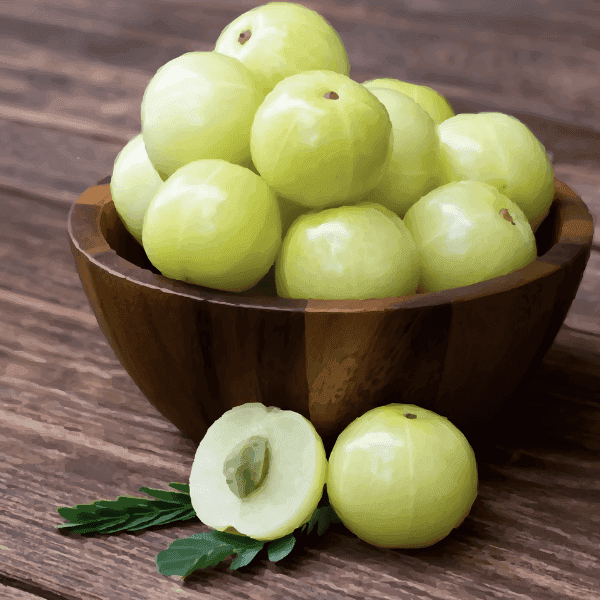
Amla Berry {Organic}
Amla berry is a berry that grows on trees and is commonly eaten. It is used in both Traditional Chinese Medicine and various folk medicine traditions for its many health benefits. Amla berry is known for being high in vitamin C and having anti-inflammatory properties. Amla berry is commonly used in capsules, powders, teas, extracts, and tinctures.
Amla berry, sometimes called amla, Indian gooseberry, or its scientific name Phyllanthus emblica, is a part of the Euphorbiaceae (spurge) family. Amla berries grow on 60-foot trees with grayish-green bark that peels off in flakes. The amla tree’s leaves come in pairs opposite of each other and are light green. Amla trees bear greenish-yellow flowers that bloom into berries that start green but turn yellow or red when ripe.
You might need amla berry if . . .
- You’d like to increase your intake of antioxidants
- You want to give your immune system some extra support
- Want to increase your intake of anti-inflammatory foods
Benefits of Amla Berry
- Antioxidant Properties
- Rich in Nutrients
- Anti-Inflammatory Properties
- May Support the Immune System
Common Ways to Use Amla Berry
You can find amla berries in dried bulk, pills, powders, teas, extracts, or tinctures. Tinctures always contain the most concentrated amount of herbs. Teas and soups are also options, especially when following Ayurvedic medicine recipes.
🌿Try making herbal extractions or this immunity tincture. ← 🟩 DIYs, recipes, and more!
Growing and Foraging Information
Alma berries thrive in well-drained, loamy soil and require full sun to produce sweet, flavorful fruit. When foraging, look for ripe berries in mid to late summer, as they can be recognized by their deep red color and small size. It's important to harvest carefully to avoid damaging the plant and to ensure sustainable foraging practices by leaving some fruit for wildlife.
Safety Concerns
According to the mainstream, amla berry is commonly consumed in food. They say it is possibly safe when used as medicine at doses of up to 1,000 mg daily for up to 6 months, 1,500 mg daily for up to 2 months, and 2,000 mg daily for up to 1 month. It is unclear if these doses are safe to take for longer periods. They claim there isn’t enough reliable information to know if Amla Berry is safe or what the side effects might be when applied topically while pregnant or breastfeeding. Additionally, they warn amla berry might increase the risk of bleeding or bruising in some people, like those with a bleeding disorder or undergoing surgery.
Drug Interaction: According to the Modern Alternative Mama and Earthley’s lead herbalist, Kate Tietje, amla berry, like many berries that are used as both food and medicine (including blueberries, elderberries, and more), are safe for daily use in moderate and high doses for all ages in most situations. If you have any health concerns or are taking any prescription medication, please consult with your healthcare provider before adding new herbs to your diet.
Breastfeeding and Pregnancy: There are no known contraindications for breastfeeding and pregnancy. I scoured many scientific databases and could not find evidence of amla berry causing issues while pregnant or breastfeeding.
Select Studies About Amla Berry
Functional and Nutraceutical Significance of Amla (Phyllanthus emblica L.): A Review
Amla is packed with beneficial compounds, especially antioxidants, which can help protect against oxidative damage and support overall health, like improving blood sugar regulation and digestive health. While there’s promising evidence for its health benefits, more research is needed to confirm these effects and explore how to effectively incorporate amla into foods.
Health Benefits of Amla (Indian Gooseberry)
The antioxidants and vitamins found in amla berries offer several health benefits. High concentrations of vitamin C in amla helps the body recover from illness. Amla berries also include several flavonols, chemicals that have been linked to benefits like improved memory.